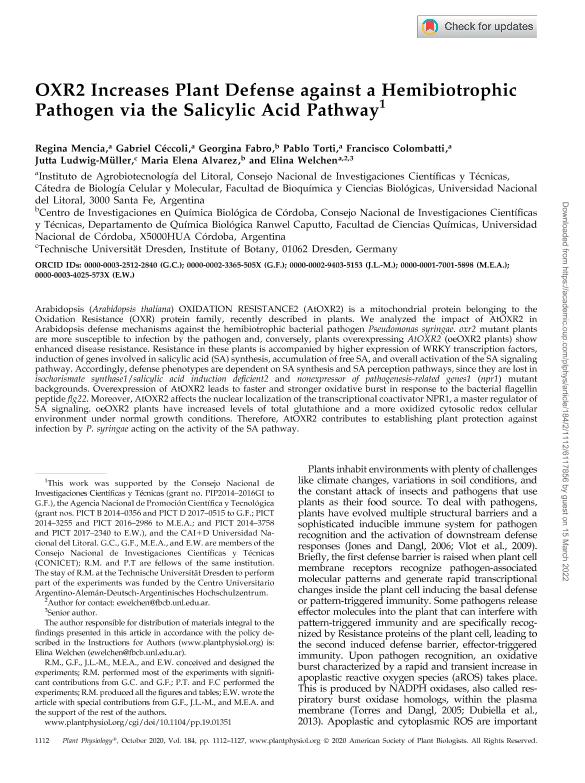Mostrar el registro sencillo del ítem
dc.contributor.author
Mencia, Regina

dc.contributor.author
Céccoli, Gabriel

dc.contributor.author
Fabro, Georgina

dc.contributor.author
Torti, Pablo

dc.contributor.author
Colombatti, Francisco

dc.contributor.author
Ludwig Müller, Jutta
dc.contributor.author
Alvarez, Maria Elena

dc.contributor.author
Welchen, Elina

dc.date.available
2020-10-02T15:26:09Z
dc.date.issued
2020-07
dc.identifier.citation
Mencia, Regina; Céccoli, Gabriel; Fabro, Georgina; Torti, Pablo; Colombatti, Francisco; et al.; OXR2 increases plant defense against a hemibiotrophic pathogen via the salicylic acid pathway; American Society of Plant Biologist; Plant Physiology; 184; 2; 7-2020; 1112-1127
dc.identifier.issn
0032-0889
dc.identifier.uri
http://hdl.handle.net/11336/115349
dc.description.abstract
Arabidopsis (Arabidopsis thaliana) OXIDATION RESISTANCE2 (AtOXR2) is a mitochondrial protein belonging to the Oxidation Resistance (OXR) protein family, recently described in plants. We analyzed the impact of AtOXR2 in Arabidopsis defense mechanisms against the hemibiotrophic bacterial pathogen Pseudomonas syringae. oxr2 mutant plants are more susceptible to infection by the pathogen and, conversely, plants overexpressing AtOXR2 (oeOXR2 plants) show enhanced disease resistance. Resistance in these plants is accompanied by higher expression of WRKY transcription factors, induction of genes involved in salicylic acid (SA) synthesis, accumulation of free SA, and overall activation of the SA signaling pathway. Accordingly, defense phenotypes are dependent on SA synthesis and SA perception pathways, since they are lost in isochorismate synthase1/salicylic acid induction deficient2 and nonexpressor of pathogenesis-related genes1 (npr1) mutant backgrounds. Overexpression of AtOXR2 leads to faster and stronger oxidative burst in response to the bacterial flagellin peptide flg22. Moreover, AtOXR2 affects the nuclear localization of the transcriptional coactivator NPR1, a master regulator of SA signaling. oeOXR2 plants have increased levels of total glutathione and a more oxidized cytosolic redox cellular environment under normal growth conditions. Therefore, AtOXR2 contributes to establishing plant protection against infection by P. syringae acting on the activity of the SA pathway.
dc.format
application/pdf
dc.language.iso
eng
dc.publisher
American Society of Plant Biologist

dc.rights
info:eu-repo/semantics/openAccess
dc.rights.uri
https://creativecommons.org/licenses/by-nc-sa/2.5/ar/
dc.subject
OXR FAMILY
dc.subject
PSEUDOMONAS SYRINGAE
dc.subject
OXIDATIVE STRESS
dc.subject
PLANT DEFENSES
dc.subject.classification
Biotecnología Agrícola y Biotecnología Alimentaria

dc.subject.classification
Biotecnología Agropecuaria

dc.subject.classification
CIENCIAS AGRÍCOLAS

dc.title
OXR2 increases plant defense against a hemibiotrophic pathogen via the salicylic acid pathway
dc.type
info:eu-repo/semantics/article
dc.type
info:ar-repo/semantics/artículo
dc.type
info:eu-repo/semantics/publishedVersion
dc.date.updated
2020-09-25T19:05:09Z
dc.identifier.eissn
1532-2548
dc.journal.volume
184
dc.journal.number
2
dc.journal.pagination
1112-1127
dc.journal.pais
Estados Unidos

dc.journal.ciudad
Rockville
dc.description.fil
Fil: Mencia, Regina. Consejo Nacional de Investigaciones Científicas y Técnicas. Centro Científico Tecnológico Conicet - Santa Fe. Instituto de Agrobiotecnología del Litoral. Universidad Nacional del Litoral. Instituto de Agrobiotecnología del Litoral; Argentina
dc.description.fil
Fil: Céccoli, Gabriel. Consejo Nacional de Investigaciones Científicas y Técnicas. Centro Científico Tecnológico Conicet - Santa Fe. Instituto de Agrobiotecnología del Litoral. Universidad Nacional del Litoral. Instituto de Agrobiotecnología del Litoral; Argentina
dc.description.fil
Fil: Fabro, Georgina. Consejo Nacional de Investigaciones Científicas y Técnicas. Centro Científico Tecnológico Conicet - Córdoba. Centro de Investigaciones en Química Biológica de Córdoba. Universidad Nacional de Córdoba. Facultad de Ciencias Químicas. Centro de Investigaciones en Química Biológica de Córdoba; Argentina
dc.description.fil
Fil: Torti, Pablo. Consejo Nacional de Investigaciones Científicas y Técnicas. Centro Científico Tecnológico Conicet - Santa Fe. Instituto de Agrobiotecnología del Litoral. Universidad Nacional del Litoral. Instituto de Agrobiotecnología del Litoral; Argentina
dc.description.fil
Fil: Colombatti, Francisco. Consejo Nacional de Investigaciones Científicas y Técnicas. Centro Científico Tecnológico Conicet - Santa Fe. Instituto de Agrobiotecnología del Litoral. Universidad Nacional del Litoral. Instituto de Agrobiotecnología del Litoral; Argentina
dc.description.fil
Fil: Ludwig Müller, Jutta. Technische Universität Dresden; Alemania
dc.description.fil
Fil: Alvarez, Maria Elena. Consejo Nacional de Investigaciones Científicas y Técnicas. Centro Científico Tecnológico Conicet - Córdoba. Centro de Investigaciones en Química Biológica de Córdoba. Universidad Nacional de Córdoba. Facultad de Ciencias Químicas. Centro de Investigaciones en Química Biológica de Córdoba; Argentina
dc.description.fil
Fil: Welchen, Elina. Consejo Nacional de Investigaciones Científicas y Técnicas. Centro Científico Tecnológico Conicet - Santa Fe. Instituto de Agrobiotecnología del Litoral. Universidad Nacional del Litoral. Instituto de Agrobiotecnología del Litoral; Argentina
dc.journal.title
Plant Physiology

dc.relation.alternativeid
info:eu-repo/semantics/altIdentifier/url/http://www.plantphysiol.org/lookup/doi/10.1104/pp.19.01351
dc.relation.alternativeid
info:eu-repo/semantics/altIdentifier/doi/http://dx.doi.org/10.1104/pp.19.01351
Archivos asociados
